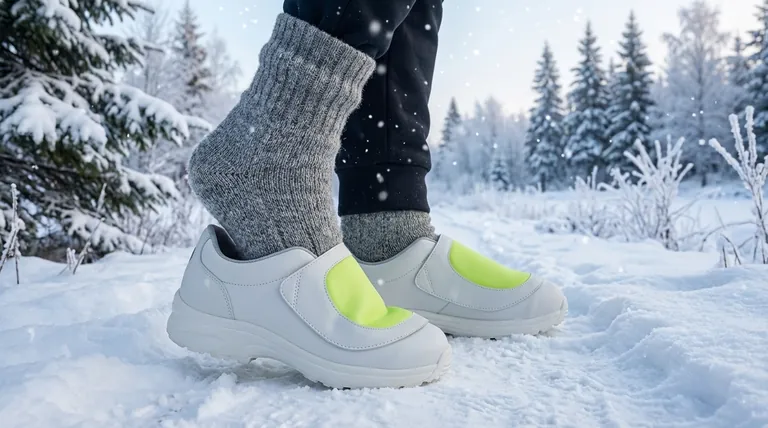To choose the right winter sock thickness, you must balance insulation with fit. The ideal sock provides warmth without being so bulky that it makes your footwear tight. A sock that is too thick will compress your foot, restrict blood circulation, and ultimately make your feet colder, not warmer.
The greatest mistake in winter foot comfort is assuming thicker is always warmer. True warmth comes from a system of two things: the sock's ability to trap air (insulation) and your body's ability to circulate warm blood to your feet.

The Science of Warm Feet: A Two-Part System
To make an informed choice, you must understand the two core principles that keep your feet warm. These factors work together, and disrupting one will compromise the other.
Insulation's Role: Trapping Warm Air
A sock's primary job is to create a layer of still air around your foot. Your body heat warms this trapped air, forming an insulating barrier against the outside cold.
Thicker socks can often trap more air, but the material is also crucial. Natural fibers like wool are highly effective because their crimped structure creates thousands of tiny air pockets.
Circulation's Role: Your Body's Natural Heater
Insulation only slows down heat loss; it doesn't create heat. The actual warmth in your feet is delivered by blood circulation from your body's core.
Robust blood flow is non-negotiable for warm extremities. If circulation is restricted, your feet will get cold regardless of how much insulation they have.
The Critical Trade-off: When "Thicker" Becomes Colder
The most common failure point occurs when the pursuit of insulation undermines circulation. This happens when a thick sock is crammed into a boot that is not sized for it.
The Compression Problem
When your boot becomes too tight, the sock and your foot are compressed. This pressure eliminates the space necessary for both insulation and circulation.
Restricting Critical Blood Flow
The most damaging effect of compression is reduced blood flow. Tightness around your foot and ankle constricts blood vessels, severely limiting the amount of warm blood that can reach your toes.
Eliminating Insulating Air Pockets
A compressed sock also loses its insulating power. The pressure squeezes out the very air pockets that are meant to hold your body heat, rendering the thickness useless.
The Layering Trap
Wearing two pairs of socks often causes this exact problem. Unless the outer sock is a larger size, layering creates intense compression, restricting blood flow and guaranteeing colder feet.
Making the Right Choice for Your Footwear
The correct sock thickness is always relative to the volume of your boots or shoes. Your goal is a snug fit with no pressure points or tightness.
- If your primary focus is everyday warmth: Choose a medium-weight sock and test it in your daily footwear. You should be able to wiggle your toes freely without feeling any tightness across the top of your foot.
- If your primary focus is active winter sports: Use a purpose-built sock designed for your activity (e.g., skiing, hiking). These socks have cushioning and thickness in specific zones but are thinner elsewhere to ensure a precise, non-restrictive fit in technical boots.
- If your primary focus is extreme cold: You must use footwear that is sized up to accommodate a truly thick, heavy-duty sock. The boot itself must provide the extra space needed to avoid compression.
Ultimately, trust the feeling of a comfortable fit over the simple promise of a thicker sock.
Summary Table:
| Key Consideration | Why It Matters | Ideal Choice |
|---|---|---|
| Insulation | Traps warm air to create a barrier against the cold. | Wool or other natural fibers for effective air pockets. |
| Circulation | Delivers warm blood to your feet; non-negotiable for warmth. | A fit with no pressure points or tightness. |
| The Trade-Off | A sock that's too thick compresses in the boot, reducing both insulation and blood flow. | Match sock thickness to your boot's internal volume. |
Need the perfect winter sock for your brand or bulk order?
As a large-scale manufacturer, 3515 produces a comprehensive range of footwear for distributors, brand owners, and bulk clients. Our expertise in materials and fit ensures your customers get the warmth and comfort they need without compromising on circulation. Let's discuss your specific requirements.
Contact our team today for a consultation!
Visual Guide

Related Products
- Customizable Slip-On Safety Shoes Direct from the Factory for Wholesale
- Wholesale Customizable Suede Safety Boots - Puncture-Proof with Velcro Closure
- Wholesale Modern Comfort Shoes with Dial Closure for Private Label & Bulk Orders
- Wholesale Comfort Dress Shoes with Dial Closure for Custom Manufacturing
- Wholesale Smart Casual Sneakers with Dial Closure | Factory Direct Manufacturing
People Also Ask
- Why is proper fit important in work boots? Ensure Safety, Comfort & Long-Term Health
- Is it normal to wear shoes in the house? A Guide to Hygiene, Comfort & Culture
- What cultural and environmental considerations are tied to wearing shoes indoors? Balance Hygiene, Tradition, and Foot Health
- What are the potential consequences of wearing improperly designed work boots? Avoid Injury & Boost Safety
- What regular maintenance checks should be performed on safety boots? A Daily Safety Checklist



















